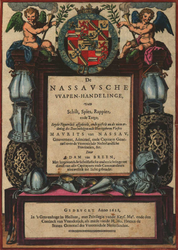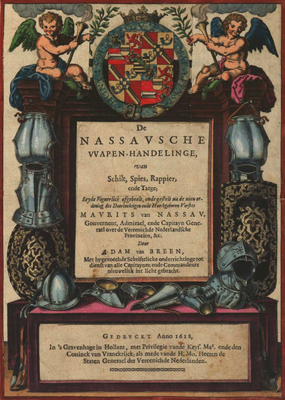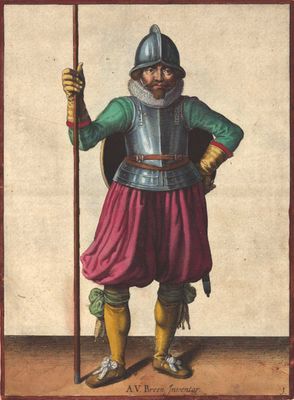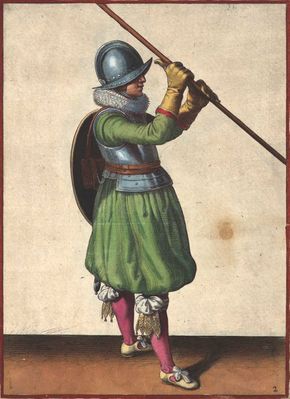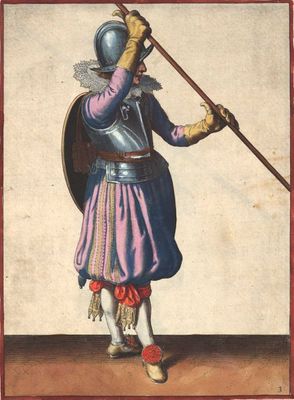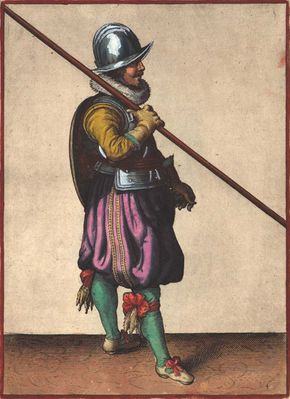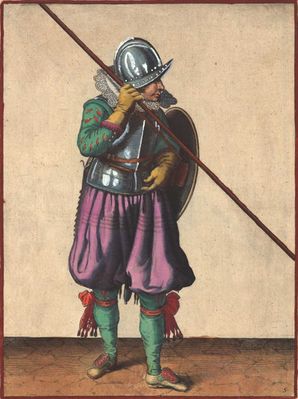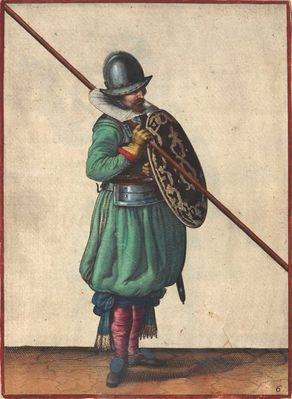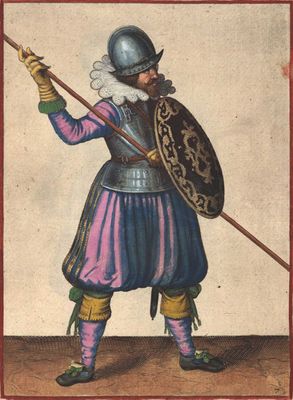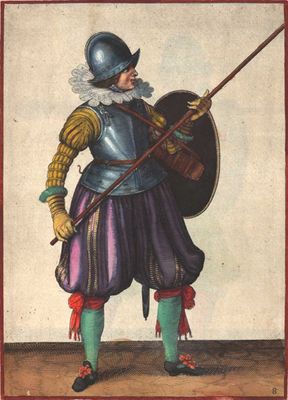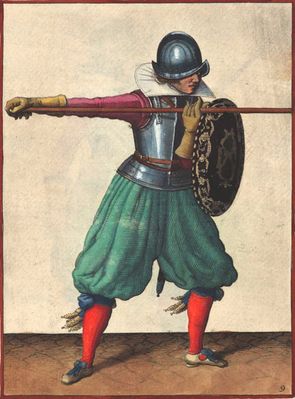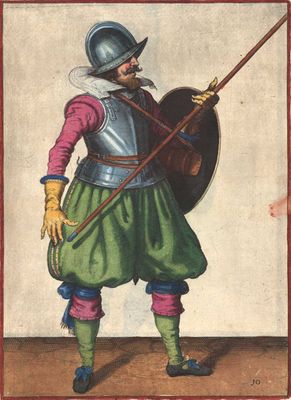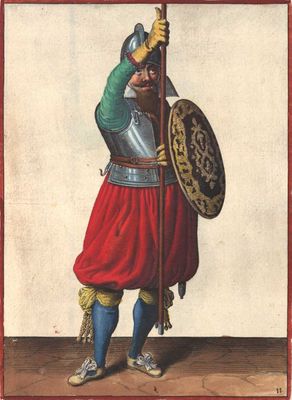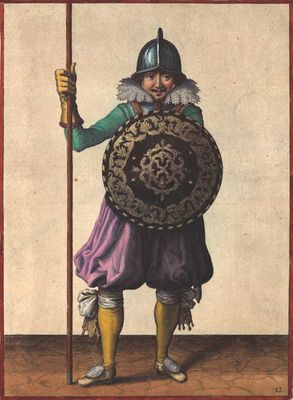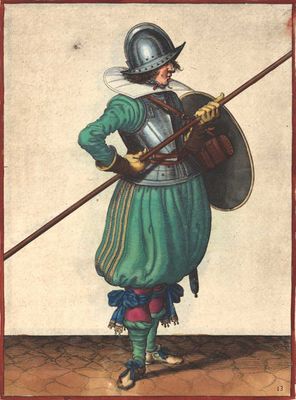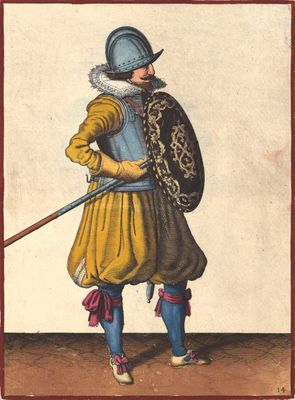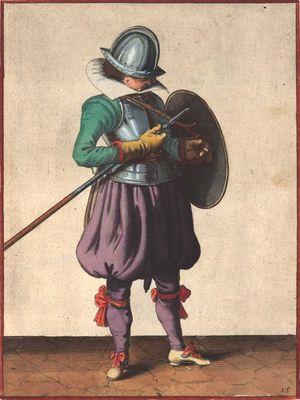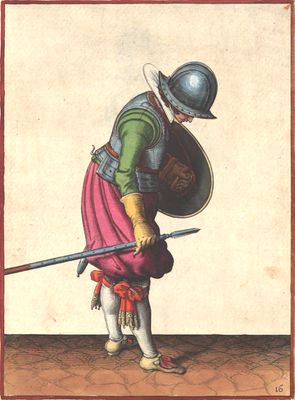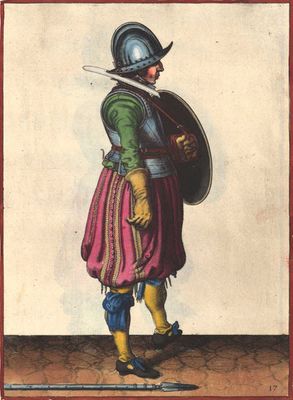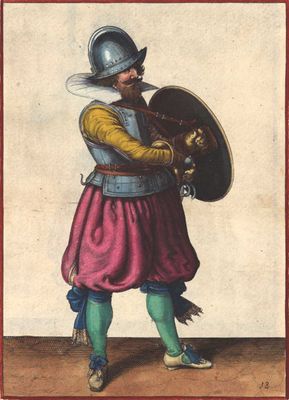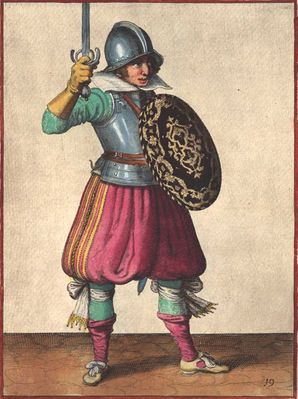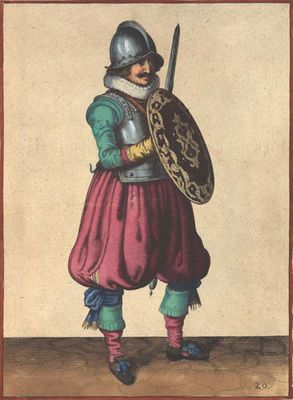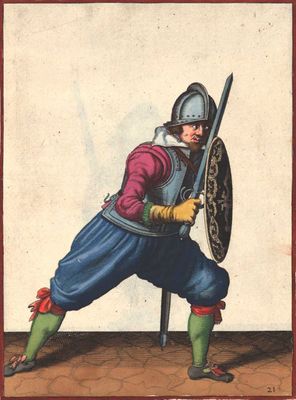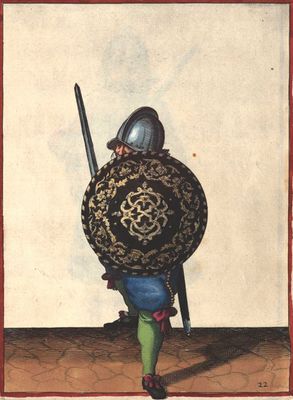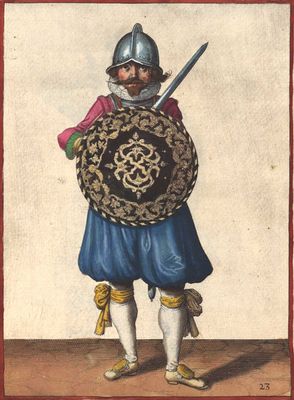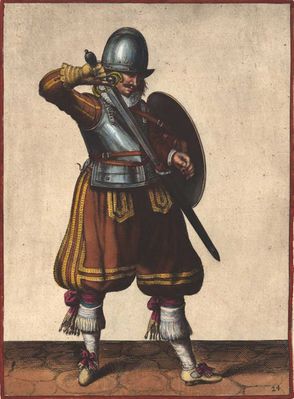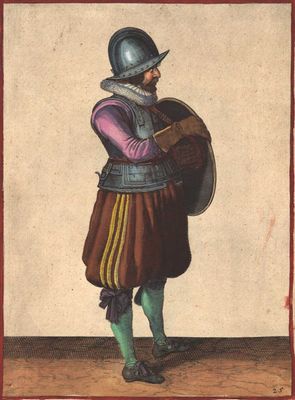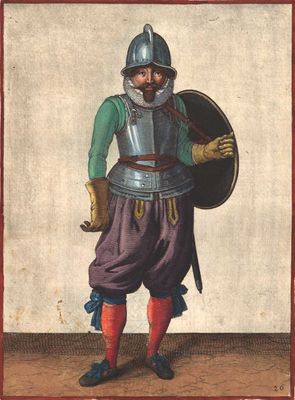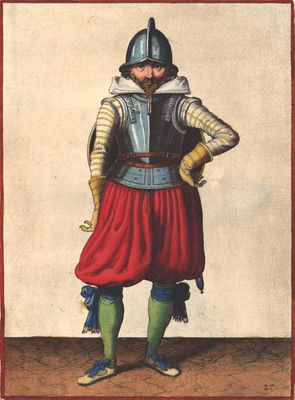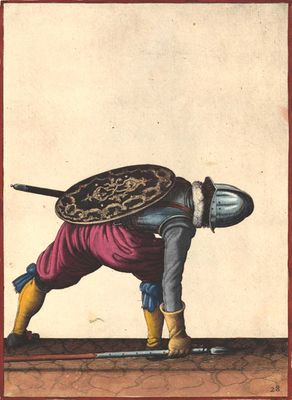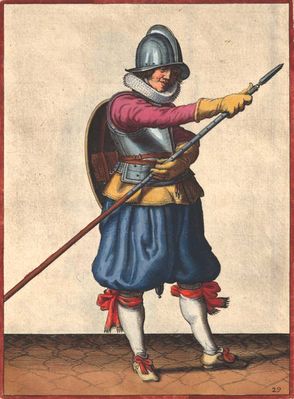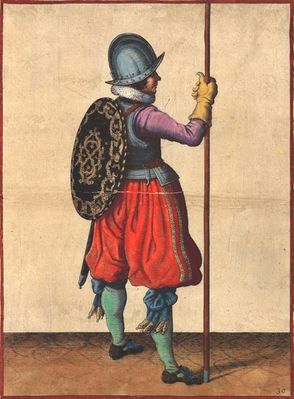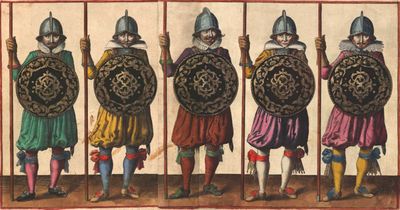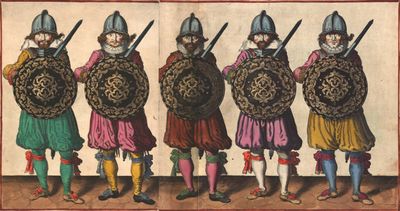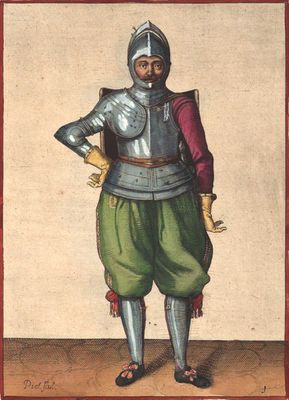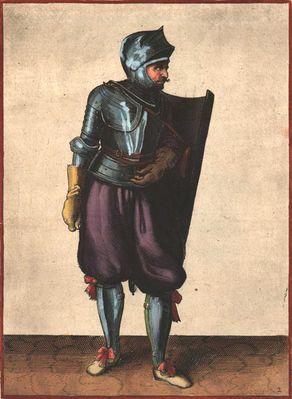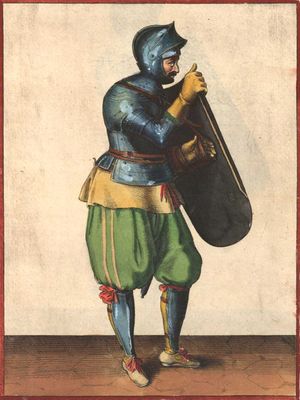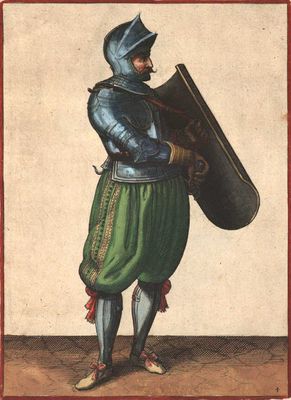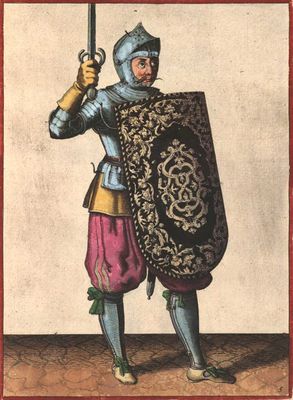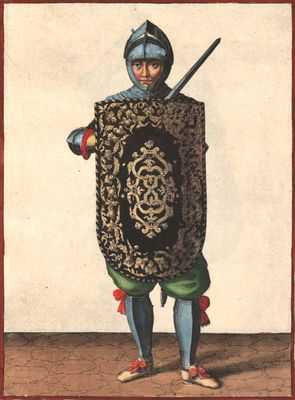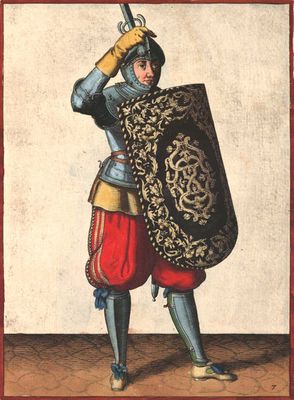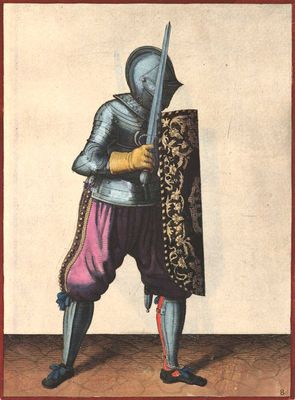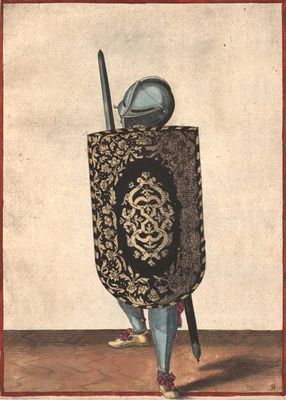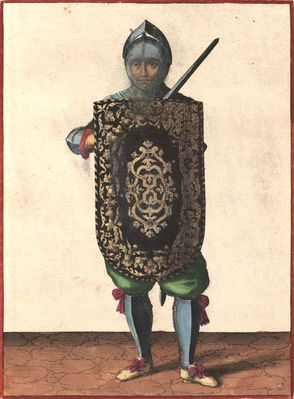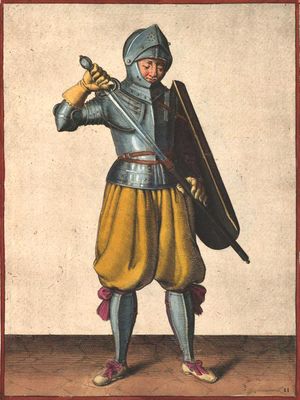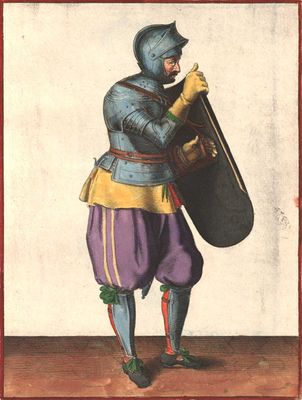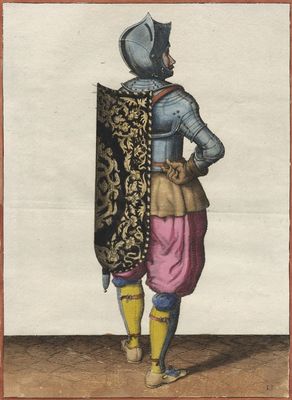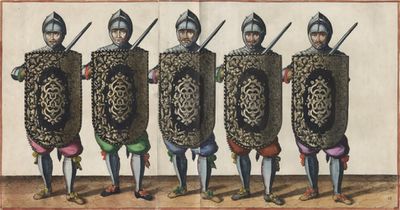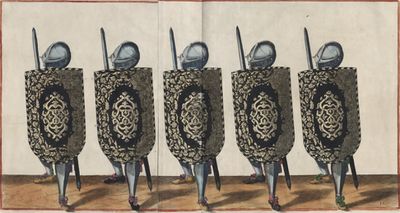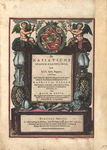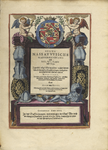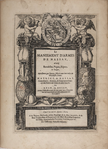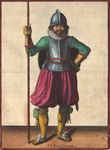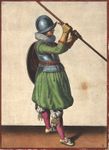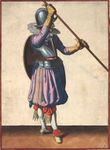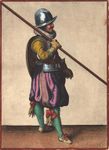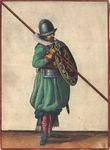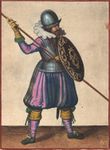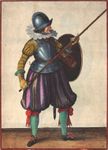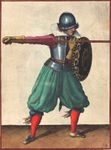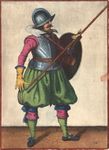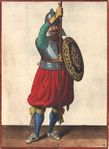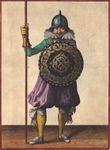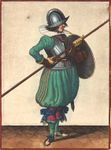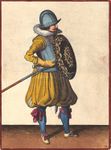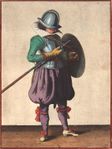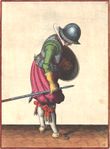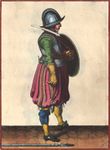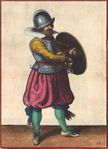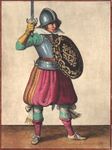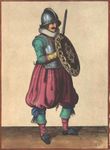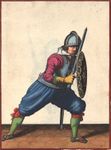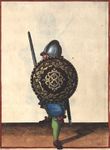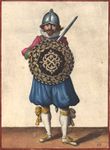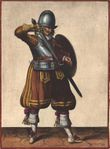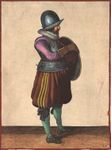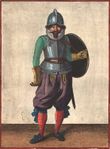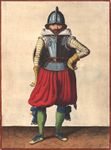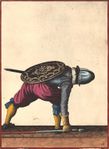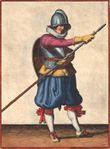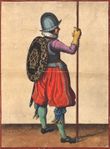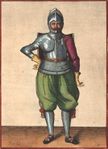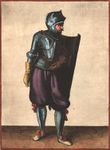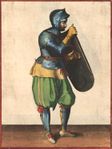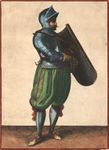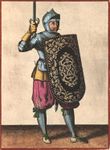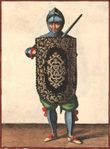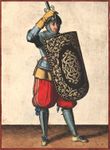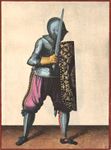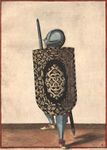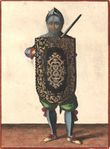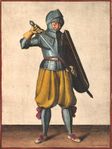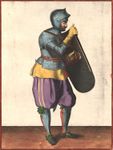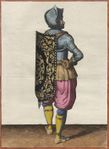Images
|
No Translation 
|
English Transcription (1625)
by Michael Chidester
|
Dutch Transcription (1618)
|
French Transcription (1618)
|
German Transcription (1618)
|
|
|
|
The exercise of armes wherein lively figures is showne the Right Use and perfect manner of Handling the Buckler Sword and Pike with the words of Command and Brefe Instructions correspondent to every Posture.
|
|
[3] Enseignement brief et succinct, sur les pourtraicts figurez, touchant le droict usage de tout ce qui est necessaire à un Soldat sur le maniment de la Rondelle, Espée & Picque: Et ceste Instruction icy est correspondente sur chasque Figure, par les Chiffres suyvants.
|
|
|
|
|
Order yor. Pike.
In the first is showne how the Soldier standing in Order with his Pike shall carry the Buckler behind on his backe, and plant the Pike against his Right foot his Arme a little bended and his hand about the height of his eyes.
|
|
Le Soldat portant la Rondelle.
1. En les exerçant avec icelle, se monstre au Soldat premieremēt, comme estant debout en ordre avec la Picque, il tiendra & portera la Rondelle bien au derriere: C’est à sçavoir, qu'il ne chargera la Rondelle point autrement, sinon sur le dos, & plantera la Picque auprès le pied droict; le bras point estendu, mais courbé, ou plié, pour pouvoir commodement joindre la Picque à costé, en ferrant les rangs.
|
|
|
|
|
Shoulder your Pike.
The 1. Motion.
How before the first changing of hold hacing the Pike in his Right hand he shall souffer it a little to fall agaist his thumbe, and take it readily with the left hand close under the right.
|
|
2. Comme pour la premiere reprise, ayant la Picque en la main droicte, il la laissera pancher quelque peu contre le poulce, & avec la main gauche tout au dessous de la droicte, l’empoignera promptement, comme ceste Figure le monstre.
|
|
|
|
|
The 2. Motion.
How for his second remove he must bring the Pike forward with his left hand, taking it backeward with the Right the more commodiously to shoulder the Pike.
|
|
3. Comme pour la seconde reprise, il portera en avant la Picque, avec la main gauche, & avec la droicte l’empoignera au derriere, pour mettre commodement ainsi la Picque sur l’espaule.
|
|
|
|
|
March with ÿor Pike sloping.
The third Motion.
How he must carrÿ his Pike sloping that he maÿ march the more readily in close troupe without daunger of hurting his follower with the point of his Pike.
|
|
4. Comme il portera la Picque de biais, pour marcher commodement en Trouppe serrée, sans s'entre-offenser les uns les autres de la poincte.
|
|
|
|
|
Prepare ÿor Buckler for ÿor. Pike
How in Marching he must carry his Buckler gracefully and keepe it neere to his Pike and to do that he must change the posture of his left foot and shakiny his left shoulder, bring the Buckler forward.
|
|
5. Comme en marchant, il portera la Rondelle au devant du rang promptement, & le tiendra prest à la Picque: A sçavoir, en changeant la posture du pied gauche, & en secoüant l’espaule gauche, tirer la Rondelle au devant.
|
|
|
|
|
Present yor Pike.
How he must hold his left hand betweene the Brases and Center of his Buckler on the forepart of his bodÿ and again shoulder the Pike as is showne.
|
|
6. Comme il tiendra sa main gauche, entre la Courroye ou Ceinture de la Rondelle au devant du Corps, & mettra la Picque derechef sur l’espaule, & la portera de biais, comme c'este Figure le monstre.
|
|
|
|
|
.1. Motion
How he shall Port or charge his Pike at three severall motions, and in the first he shall take the Pike forward with the left hand standing upright, the better to cast over the Pike.
|
|
7. Comme il presentera la Picque en trois temps passant dessoubs une Porte, ou autrement: Et pour la premiere reprise, il enlevera la Picque de la main droicte, de dessus l’Espaule au derriere: Et de la main gauche l'empoignera promptement, pour ainsi commodement la mettre au devant de la main droicte.
|
|
|
|
|
2 Motion
Having presented the head of the Pike forward he shall take it at the butt and let it sinke handsomely downewards the better to passe throug the Port etc.
|
|
8. Comme apres avoir desja presenté la Picque avec la poincte au devant, par la seconde reprise, il la prendra de la main droicte au bout d’en bas, & la laissera couler de haut en bas commodement, pour pouvoir ainsi baiser la Picque, devant basse.
|
|
|
|
|
3. Motion
How if he will charge he shall hold it well in the Right hand, his arme being strecht out, setting his left elbowe fast against his hippe.
|
|
9. Comme il baissera à la troisiesme fois la Picque, tenant le bras droict bien fort estendu: Et de la mesme main droicte la tiendra bien ferme, & du coulde gauche la plantera fermement contre la hanche, comme il se trouvera en ceste Figure.
|
|
|
|
|
Order yor. Pike.
1. Motion
How he shall set downe the Pike at three motions and in the first he shall put downe the but and with his right hand, the easier to raise the point of the same.
|
|
10. Comme il remettra en terre sa Picque en trois temps: Premierement il la relaschera de la main droicte au bout, & la laissera couler.
|
|
|
|
|
2. Motion
How in the second he shall take the Pike as farre as he can easily reach with the right hand above the left bringing it downeward.
[Repeats on subsequent page]
|
|
11. Comme il laissera couler la Picque contre la main gauche pour la seconde-fois, pour ainsi de la main droicte la remettre en terre.
|
|
|
|
|
|
|
12. Comme il tiendra la Picque pour la troisiesme-fois en la main droicte, ainsi qu’il a esté dit, contre le poulce aupres du pied droict, pour la manier ainsi tant plus commodement.
|
|
|
|
|
Trayle yor. Pike.
How to trayle the Pike he must by Palming the handle the same backeward till he shall bring his right hand close to the head of it.
|
|
13. Comme il trainera la Picque: Premierement il luy faudra laisser couler la Picque du derriere, & la paumer jusques à ce qu'il la puisse prendre prés de la poulce, & la trainer, le fer hors de la main.
|
|
|
|
|
How
How thus trayling he must hold the Pike neare to the Point right against his girdle stead resting his hand on his hippe, as in the figure appeareth.
|
|
14. Comme en trainant ainsi la Picque, il la portera, & l'empoignera prés de la poincte: & la faudra tenir de la main droicte vis à vis de la ceincture.
|
|
|
|
|
Make readÿ yor Buckler for ÿor sword.
How he must hold his Buckler ready for his sword bearing it a little from his body that he maÿ traverse the sword a croße within his buckler.
|
|
[4] 15. Comme il tiendra prest la Rondelle pour l’Espee, & ainsi luy faudra desioindre sa Rondelle quelque jeu du Corps, pour passer le bras gauche, ou traverçer des Croses par dedans la Rondelle.
|
|
|
|
|
Laÿ downe ÿor Pike.
How he must lawÿ downe the Pike on the ground at his right foot, that is, he must bend to the same side, that the Pike may fall the more freely without daunger
|
|
16. Comme il mettra sa Picque en terre aupres son pied droict: A sçavoir, qu’il se baissera à ce mesme costé avec la Picque, pour la laisser librement couler en terre, afin de ne l’endommager.
|
|
|
|
|
How he must stand upright with his Buckler in readines, his Pike layd at his right foot expecting further command
|
|
17. Comme il se tient debout, & tout prest avec la Rondelle: Et la Picque joinct à son pied droict, attendāt quelque ulterieur commandement.
|
|
|
|
|
Draw yor. sword.
How we shall most conveniently draw his sword that is he must hold his Buckler a little from his bodÿ that it may be no hinderance to the drawing of the same.
|
|
18. Comme il tirera son Espée le plus commodement: A sçavoir, qu’il sera tenu d’esloigner du corps quelque peu sa Rondelle, afin qu’il puisse sans aucun empeschement tirer son Espée.
|
|
|
|
|
Present yor Sword.
How in presenting of his drawne sword he shall hold the same no higher then his face as appeareth.
|
|
19. Comme en la representation de son Espée tirée, il tiendra la main non plus haut, que son visage.
|
|
|
|
|
Put yor sword between your Buckler and left shoulder.
How resting his Buckler against his body and left shoulder he must bring his sword betweene towards the left shoulder, attending in this posture further Command.
|
|
20. Comme tenant derechef la Rondelle contre son Corps, & l’Espaule gauche, il luy saudra mettre son Espée entre deux vers ladite Espaule: attendant ainsi en telle posture ce que luy sera commandé de l’Officier.
|
|
|
|
|
Guard ÿour selfe.
How to gard himselfe before the enemy he must rest his Target against his left thigh and shoulder firme, the hilt of his sword against the verge of his Target inward, and the left brimme of his morion against the inside of his Target to gard his sight and view the enemy.
|
|
21. Comment il se couvrira devant son Ennemy, à sçavoir, qu’il luy faudra poser sa Rondelle contre la cuisse gauche, bien ferme contre la mesme Espaule: Et la garde de son Espée contre le bord de fa Rondelle, par dedans, afin que cela puisse soustenir le coup: & aussi le bord gauche de son Morillon, contre le bord de la Rondelle, par dedans, pour contregarder sa veüe, & tant seulement prendre garde, de quel costé son Ennemy le viendra attacquer.
|
|
|
|
|
A second garding Posture.
Here is represented how the Soldier may gard him self with his Target against the point of the enemies Pike. bearing his sword as in the precedent figure.
|
|
22. Nous representons icy, comme le Soldat se pourra couvrir soy-mesme avec la Rondelle, contre le coing du Picque, son Espée, comme en la precedente Figure.
|
|
|
|
|
Releeve your selfe.
How standing upright it will be most expedient for him to set forward his left foot and shoulder that he may rest the Target against his body and that in a free and no enforced posture.
|
|
23. Comme il se redressera en la posture, à sçavoir, se tenant debout, ce sera le plus commodieux de mettre au devant le pied gauche, & l’espaule gauche, pour y faire appuyer, ou reposer le mesme costé de la Rondelle encontre, & monstrer une posture bien libre, & non forcée, Et tout quant & quant, afin que le bras droict soit mis derechef avec l’Espée vers l'espaule gauche entre la Rondelle, comme cela est enseigné de mesme en la vingtiesme Figure.
|
|
|
|
|
Put up yor. Sword.
How in sheathing his sword with the right hand he must beare the Buckler backeward on his body that he may do it without any impediment.
|
|
24. Comme en remettant l’Espée au fourreau avec la main droicte, il luy faudra tenir la Rondelle arriere le corps, pour le faire sins empeschement.
|
|
|
|
|
Draw yor. armed out of the braces of your Buckler
How when he shall draw his arme from out the braces of his Buckler he shall hold the Buckler firme with his right hand.
|
|
25. Cōme il retirera son bras hors de la courroye de la Rondelle, il luy faudra tenir ferme la Rondelle avec la main droicte.
|
|
|
|
|
Put yor. Buckler behind yor. backe.
How when he removes againe the Buckler to his backe, it must be done with his left arme as appeareth in the figure.
|
|
26. Comme il remettra derechef la Rondelle sur le dos: il faudra que cela se face du bras gauche, comme cela se puisse voir à la Figure.
|
|
|
|
|
How the Soldier standing upright with the Buckler at his backe shall attend further Command.
|
|
27. Comme se tenant debout avec sa Rondelle sur le dos, il attendra autre commandement.
|
|
|
|
|
Take up yor. Pike.
How he must raise his Pike as high as he can standing firme with his right foot and drawing backe his left, that without forcing he maÿ bend himselfe sidewayes towards the Pike for the handling it again.
|
|
28. Comme il relevera de terre sa Picque pour la premiere fois, il la luy faudra lever en haut, avec la main, tant qu’il sera possible: Et par ainsi sera necessaire, qu’il se tienne ferme de son pied droict sur le mesme lieu, & du pied gauche tirer en arriere si avant, afin que sans le forçer, il puisse se baisser du costé vers la Picque, pour l’en-lever, ou reprendre.
|
|
|
|
|
|
|
29. Comme il empoignera la Picque derechef de la main gauche pour la seconde-fois, afin de la relever, & redresser.
|
|
|
|
|
|
|
30. Comme il remettra la Picque pour la troisiesme & derniere-fois, & la remettra derechef aupres du pied droict, la tenant en la main droicte, avec le bras plié, ou courbe, comme la premiere Figure l’enseigne.
|
|
|
|
|
|
|
31. Icy sont representées cincq Figures, pour monstrer combien prés serrées il leur faut se tenir en leur ordre, à sçavoir, si prés qu’il sera possible: Et selon que le Capitaine, ou l’Officier trouvera bon & convenable, à l’advenant des occasions.
|
|
|
|
|
Here also is represented a Ran[...]
to showe how they maÿ shut their [...]
no waies hindering them) ÿet so th[...]
quisite place, to the end that ea[...]
draw his sword and use it agai[...][1]
|
|
32. Voicy encore un rang seul, avec la Rondelle & l’Espée, pour monstrer comment on les peut serrer encores plus prés, pource que la Picque ne l’empesche: Si est-ce toutes-fois, qu’il faudra que les Rondelles des rangs entre-deux tiennent leur place convenable, afin que chacun y puisse tirer commodement son Espée, & s’en servir contre l’Ennemy.
[5] Mais apres qu’ils sçauront le maniement, les Soldats pourront estre exercéz suyvant les paroles de commandement, lesquelles sont cy apres couchées sans la notation des intervalles du temps.
|
|
